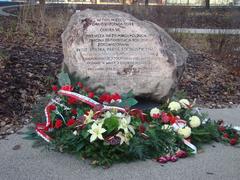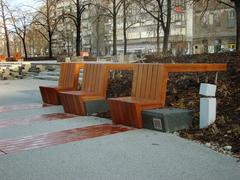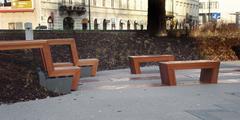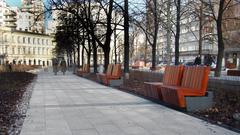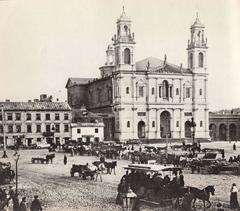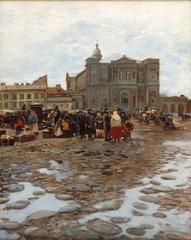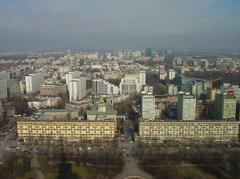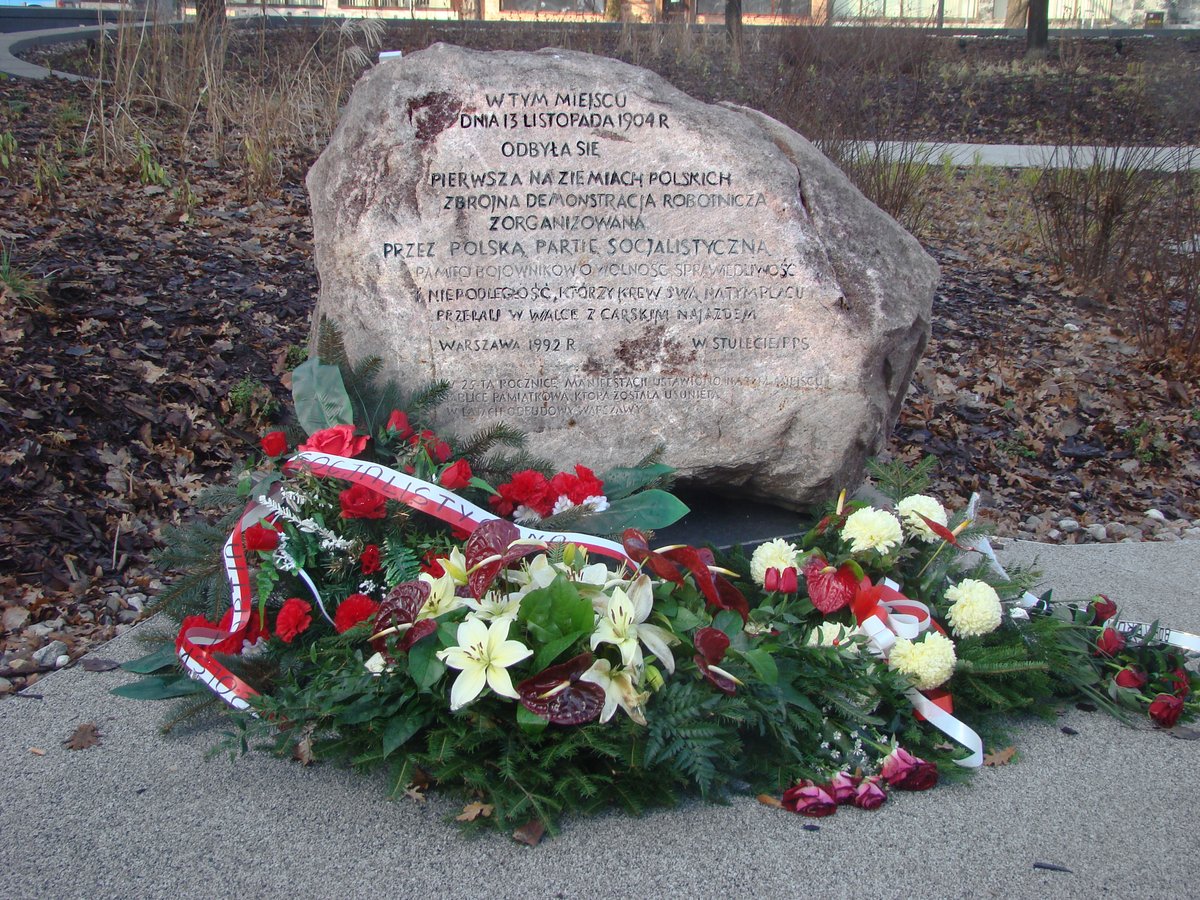
Grzybowski Square Warsaw: Visiting Hours, Tickets, and Historical Sites Guide
Date: 14/06/2025
Introduction
Grzybowski Square (Plac Grzybowski) is one of Warsaw’s most historically significant and culturally dynamic public spaces. Located in the heart of the Śródmieście district, it stands as a testament to the city’s layered past, marked by vibrant Jewish heritage, wartime trauma, postwar reconstruction, and contemporary urban revival. Today, Grzybowski Square is a living memorial and a modern gathering place, accessible to all and surrounded by landmarks that narrate the city’s complex journey through history.
Whether you are a history enthusiast, a culture seeker, or a traveler looking for authentic experiences, this comprehensive guide provides everything you need to know about visiting Grzybowski Square—including practical information on hours, tickets, accessibility, nearby attractions, guided tours, and tips for making the most of your visit.
Historical Overview
Origins and Early Development
Grzybowski Square evolved from the 17th-century village of Grzybów, which became part of Warsaw’s growing urban landscape by the late 1700s. Initially serving as a bustling marketplace (Rynek Grzybowski), the square’s early years were defined by vibrant commerce and civic life. Its triangular shape, a legacy of its historical development, sets it apart among Warsaw’s public squares.
19th-Century Transformation
The 19th century brought significant urbanization and architectural growth to Grzybowski Square. The construction of the Church of All Saints (1861–1893), alongside elegant neoclassical townhouses, integrated the square into Warsaw’s expanding city center. Streets like Próżna and Twarda became lined with tenements and shops, reflecting the area’s growing importance as a residential and commercial hub.
Jewish Heritage and the Interwar Period
By the late 19th and early 20th centuries, Grzybowski Square had become a focal point of Jewish life in Warsaw. The surrounding neighborhood, including Próżna Street and the Nożyk Synagogue (built in 1898), flourished as centers of Jewish culture, commerce, and religious practice. After World War I, the square further transformed into a green, social space—uniting Warsaw’s diverse communities.
World War II and the Warsaw Ghetto
During World War II, Grzybowski Square became part of the Warsaw Ghetto’s “Small Ghetto,” witnessing immense suffering, resistance, and loss. The Nożyk Synagogue was repurposed by the Nazis and survived the war, while much of the area was devastated by bombings and the Holocaust. Postwar, the square’s reconstruction left visible scars—bullet holes, ruined facades, and a changed urban fabric—while also preserving essential fragments of prewar heritage.
Postwar Reconstruction and Modern Revival
After 1945, socialist urban planning reshaped the square, introducing modernist housing and broad avenues. In the early 21st century, a major revitalization (completed in 2010) restored green spaces, added water features, and revitalized historic buildings, blending memory with modernity. Today, Grzybowski Square is a harmonious mix of restored tenements, sleek glass towers, and thoughtfully designed public spaces.
Key Attractions and Points of Interest
Nożyk Synagogue
The Nożyk Synagogue, just off Grzybowski Square, is the only prewar synagogue in Warsaw to survive the Holocaust. Today it remains an active place of worship and a symbol of Jewish resilience. Visitors can tour the synagogue and participate in guided visits:
- Hours: Monday–Friday, 10:00 AM–4:00 PM (hours may vary during religious events)
- Tickets: Small donation or entry fee (10–20 PLN); check ahead for guided tour schedules
Church of All Saints
This imposing neo-Renaissance church, built in the 19th century, dominates the square and played a crucial role during the Ghetto period by sheltering Jews and hosting underground aid efforts. The church is open daily, with longer hours on Sundays.
Próżna Street
The last surviving fragment of prewar Jewish Warsaw, Próżna Street features restored tenements, atmospheric cafes, and cultural venues like the Austrian Culture Forum. It’s also a focal point for the annual Warsaw Jewish Festival.
Jewish Theatre
A cornerstone of Jewish cultural life, the Jewish Theatre presents Yiddish classics and contemporary plays. Check the theatre’s website for schedules and ticket information.
Memorials and Art Installations
Throughout Grzybowski Square and adjacent streets, plaques, stone markers, and photographic installations commemorate the Jewish community, the Warsaw Ghetto, and the city’s wartime experience.
Visiting Hours and Tickets
- Grzybowski Square: Open 24/7, free entry
- Nożyk Synagogue: Monday–Friday, 10:00 AM–4:00 PM; tickets/donations required
- Church of All Saints: Monday–Saturday, 9:00 AM–6:00 PM; Sunday, 7:00 AM–8:00 PM; free entry
- Jewish Theatre: Schedules vary; tickets required for performances
For updated hours and ticket information, check official websites or contact venues directly.
Getting There and Accessibility
- Location: Plac Grzybowski, 00-109 Warszawa, Poland
- Public Transport: Nearest metro stations—Świętokrzyska (M1, M2) and Rondo ONZ—are within a 5–10 minute walk. Numerous tram and bus lines serve the area.
- Cycling: Veturilo bike stations are nearby.
- Parking: Limited street parking and underground garages at nearby shopping centers.
- Accessibility: The square has paved, step-free paths and ramps suitable for wheelchairs and strollers. Most modernized buildings are accessible, but some historic structures may have limitations.
Visitor Experience and Practical Tips
- Best Times to Visit: Spring and early autumn (pleasant weather); early mornings and late afternoons for photography and quieter atmosphere
- Tours: Guided walking tours (private and group) focusing on Jewish heritage and Warsaw Ghetto history are available; self-guided routes are well-marked with bilingual plaques
- Dining: Próżna Street and the square’s perimeter offer cafes, restaurants, and bakeries—some with Jewish or Polish specialties
- Restrooms: Available in cafes and some public buildings
- Safety: Central location with regular police patrols; safe day and night; remain respectful at memorials and religious sites
- Cultural Etiquette: Modest attire for religious sites; photography welcome in public areas but ask permission in places of worship or during events
Events and Special Occasions
- Warsaw Jewish Festival: Annual late-summer celebration with concerts, performances, and food stalls
- Commemorative Ceremonies: Holocaust Remembrance Day, Warsaw Uprising anniversaries, and other memorial events
- Cultural Events: Regular exhibitions and concerts at the Austrian Culture Forum and Jewish Theatre
Suggested Itineraries and Nearby Attractions
- POLIN Museum of the History of Polish Jews: 20-minute walk north; offers comprehensive exhibitions on Jewish history in Poland
- Jewish Cemetery and Ghetto Wall Remnants: Short tram or taxi ride away; essential stops on a Jewish heritage tour
- Palace of Culture and Science: 10-minute walk; observation decks and cultural venues
- Warsaw Old Town: UNESCO-listed district, within easy reach for a half-day or full-day itinerary
Frequently Asked Questions (FAQ)
Q: Is there an entrance fee to visit Grzybowski Square?
A: No, the square is a public space with free access at all times.
Q: What are the visiting hours for the Nożyk Synagogue?
A: Monday to Friday, 10:00 AM–4:00 PM. Check ahead for religious holidays or special events.
Q: Are guided tours available in English?
A: Yes, many tour operators offer English-language tours focused on Jewish heritage and Warsaw’s history.
Q: Is Grzybowski Square accessible for wheelchair users?
A: Yes, the square and most nearby attractions are wheelchair accessible.
Q: Can I take photos inside the synagogue?
A: Photography is generally discouraged during services; always ask for permission.
Q: Where can I find more information about events or book tours?
A: Check the official WarsawTour, In Your Pocket, and AB Poland sites.
Visual and Media Resources
- High-quality images of Grzybowski Square, All Saints Church, and Nożyk Synagogue are recommended for planning and inspiration.
- Interactive maps and virtual tours are available via the official tourism website.
- For alt text and SEO: Use descriptions like “Grzybowski Square with All Saints Church” and “Nożyk Synagogue entrance.”
Plan Your Visit & Stay Connected
Grzybowski Square offers a profound journey through Warsaw’s past and present. Plan your visit during spring or autumn for ideal conditions, join a guided tour for deeper context, and explore the square’s vibrant surroundings at your own pace.
Download the Audiala app for interactive maps and self-guided routes, follow our social media for updates and travel tips, and immerse yourself in the living history of Grzybowski Square.
References
- Grzybowski Square in Warsaw: Visiting Hours, Historical Highlights, and Travel Guide, 2025, WarsawTour (https://www.warsawtour.pl/en/historical-sites)
- Grzybowski Square Warsaw: Visiting Hours, Tickets, and Historical Guide, 2025, In Your Pocket (https://www.inyourpocket.com/warsaw/Plac-Grzybowski_74198f)
- Visiting Grzybowski Square: Hours, Tickets, and Warsaw Historical Sites Guide, 2025, AB Poland (https://abpoland.com/attractions/former-ghetto)
- Grzybowski Square Visiting Hours, Tickets, and Guide to Warsaw’s Historic Site, 2025, Warsaw Hostel Centrum (https://warsawhostelcentrum.pl/en/history-lesson/265-grzybowski-square)
